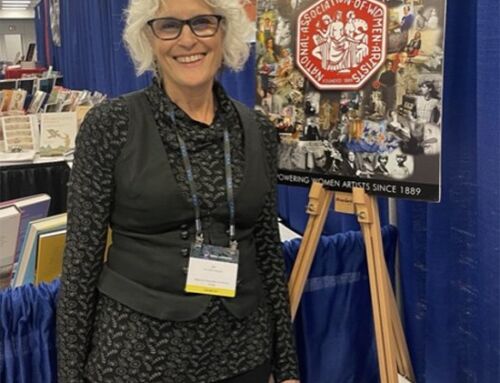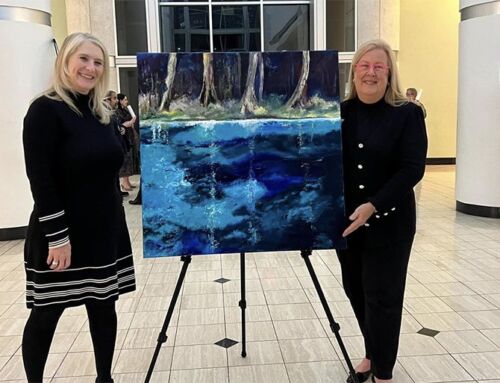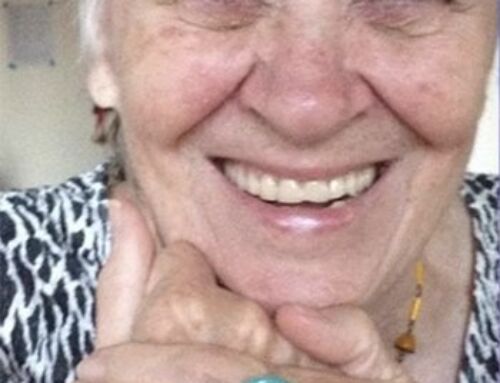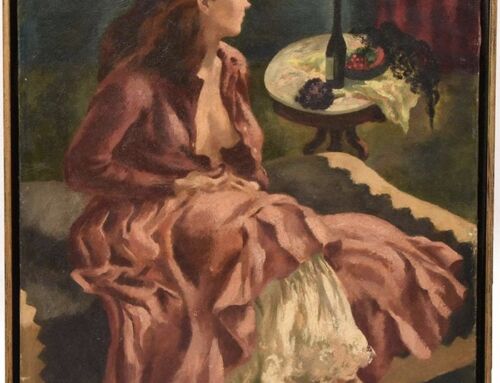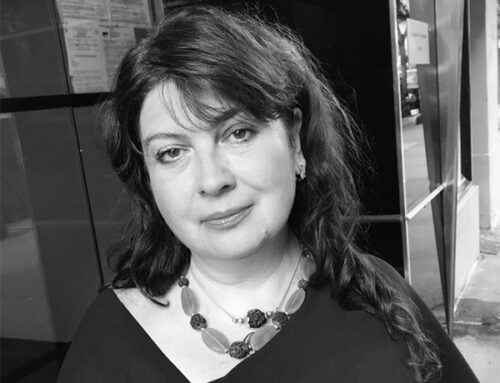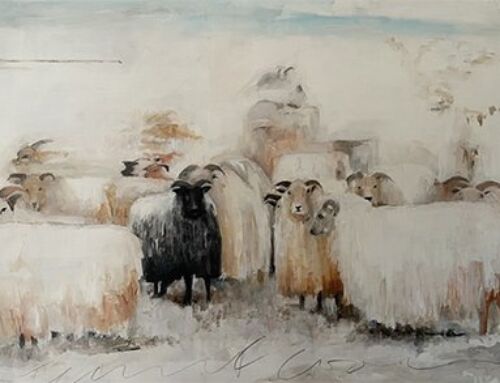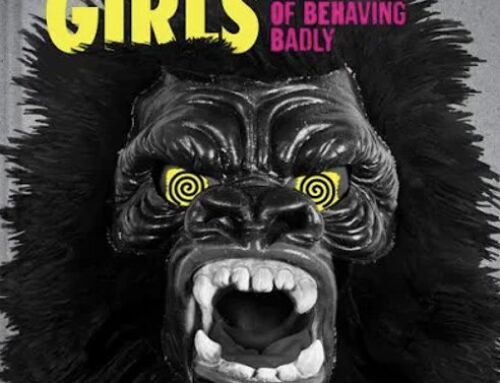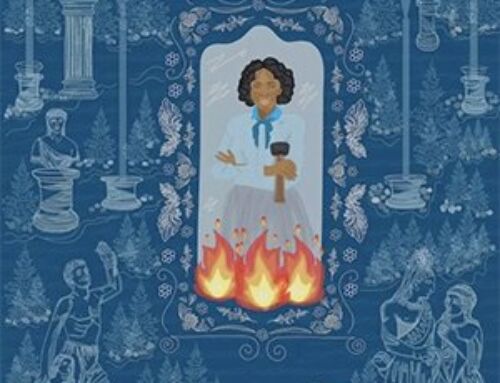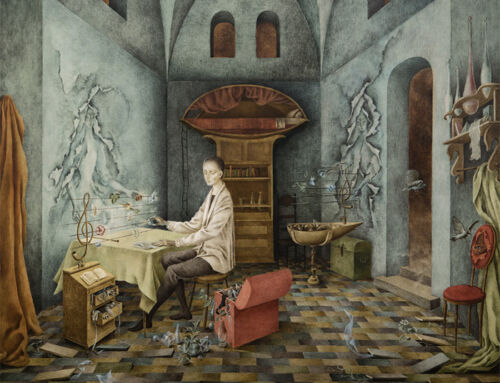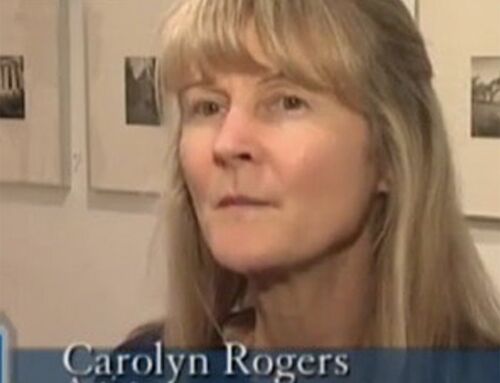DIGITAL ART: A Deeper Look
Four NAWA artists in discussion
In this issue, NAWA NOW Magazine interviews four members who practice in the field of digital art. Their trail-blazing stories are inspirational. We asked Fleur Spolidor, Mayya Bork, Roz Dimon and Diana de Avila to share the challenges and joys of working in digital art, and to discuss their inspirations.
NOW: Please briefly share with us your background and your history with NAWA.
FLEUR SPOLIDOR: I’ve been a NAWA member for less than 2 years. After living in Paris, San Francisco, Zurich, Amsterdam and Manhattan, I now live and work in Rye, New York. My work is about women’s rights and climate change. Recently, I’ve been painting “The Swimsuits series: A pictorial reflection on women’s rights”. This series was selected for display at the European delegation to the United Nations during the 67th Commission on the Status of Women. This same series was awarded a 2023 Arts Alive grant by the New York State Council on the Arts and was on display at the Jay Heritage Center in Rye, New York for two months.
MAYYA BORK: I’m a Russian-American visual artist. I hold a Master of Fine Arts, Fine and Visual Arts, 2005-2011, Russia. I hold a Bachelor of Arts, Intercultural Studies, SCSU, Los Angeles, 2017-2020. Even though my strongest skill lies in drawing (I was taught in the traditional Russian academic drawing technique: optical and observational drawing approach), I diversified my skill set by working with photography, illustration, and stage design. I’ve self-published four children’s books. For the past 10 years, I’ve worked as a stage designer creating scenery for projects like THE ILLUSIONISTS – LIVE FROM BROADWAY™, DCapella Disney Music Group, Disney Pixar Coco: A Live-to-Film Concert at the Hollywood Bowl, Disney Princess: The Concert, and Jingle Ball iHeart RADIO – Madison Square Garden. I moved to New York in 2022 and was inducted into NAWA in 2023. Currently, I live in the Seaport district of Manhattan.

Left: Princess Jasmine’s Room for Disney Princess, The Concert (Digital Art); Right: The Moroccan Magpie (from Morakka); both digital images by Mayya Bork
ROZ DIMON: I live in the Town of Shelter Island, New York, but according to my recent iPhone report, I spend six hours a day on a different planet altogether – a statistic that is an improvement from last week’s eight hours per day. Like many, I find myself caught in a life/time/space warp between the real and the virtual. I joined NAWA in 2023 and am so pleased to be part of this powerful group of professional women artists.
DIANA DE AVILA: I was accepted into NAWA in 2021 and have been a digital artist since 2017. I have no formal art training and received art ability suddenly (like a superpower) in June 2017 after worsening multiple sclerosis. I live and create art in Sarasota, Florida, and show my tech-driven art at Define Art Gallery.
NOW: When did you start using digital media and why?
FLEUR SPOLIDOR: Around 10 years ago I became interested in this “new” technology, painting and sketching, first on my iPhone and then on an iPad with apps like Procreate or Art Rage. The idea was to replace my watercolor traveling kit and avoid the inevitable water spills when painting on the plane or on the train. I spent an entire summer learning how to use the iPad and iPen, watching YouTube videos or creating very ugly art pieces to try every possible option and permutation in the different apps I was uploading. It was trial and error and it was a lot of fun.
I have two distinct bodies of work, each with its own technique. When painting about women’s rights, I work with oils and acrylic on mixed media collages of recycled materials. I really enjoy working in layers, experimenting and pushing the possibilities of the materials. Getting my hands dirty is very satisfying. My work about global warming is specifically created on my iPad, using digital collage, layering, fusing, erasing and colorizing old photographs with the Apple pen. My interest is in the old black and white photographs – witnesses of past events – in which the discoloration and imperfections give a romantic polish to the scene, dimming the pain of the protagonists while keeping the surrealism. In combining these images, I try to present the evidence of our limited memory and our failure to plan for the long-term future.

Left: Oxygen; Right: School of Fish; both Digital Art by Fleur Spolidor
MAYYA BORK: I like using different mediums to create art but I particularly like trying new ways of bringing my ideas to life. I got my first tablet in college because I saw the obvious benefits of using it for graphic design projects. After trying different digital brushes, I realized I can achieve pretty interesting results in digital painting and drawing as well. The freedom it gave me compared to a mouse was unparalleled. So, I started experimenting more with it. I would make various images on my computer for myself or my friends just to see what range of techniques I could cover.
ROZ DIMON: It’s all been an accident — a giant interruption in my plans to simply move from my native Atlanta and become a famous artist (alongside the other 5 million artists arriving in New York City in 1981.) I was working in oil-on-canvas (what else?), the primary medium of painters for the past millennium (Not that I’m against it — I actually feel I’ll be going back to this soon) when my paintings on their way to stardom began to fill with electronic squares … a response to an electronic phenomenon called “pixels” that would soon engulf America and the world. I called these works, “INFORMATION PAINTINGS” as indeed, I was painting information.

Left: Bar Talk, Natural Media; Right: Washington Pig, Digital Media, both by Roz Dimon
(1800 px high at 300 dpi)
This led me to take the earliest course offered in digital art at The School of Visual Arts. If as McLuhan said “the medium is the message” then this was a medium I had to have. By the late 1990s, while showing my work internationally in the earliest venues of digital art, I was heading up the first new media divisions for corporate titans like the new Wall Street Journal Online at the World Trade Center. I also worked with Ricco Maresca Gallery in Soho to curate/create ‘code’, an exhibition of digital art that had sponsors from Apple, IBM and SoftImage to Alias Wavefront, and a line of 300 people around the block on opening night.
DIANA deAVILA: In 2017, I dove into art with a strong urge to create because of my artistic awakening. After a brief stint in traditional mediums, I discovered my true knack for creating art using technology. Given my love for computers, working with digital media became thrilling and fulfilling despite how exhausting the compulsion felt. My artistic voice will always involve digital art. I can’t imagine it any other way, but who knows what the future will bring?
NOW: Discuss the joys and challenges of working in this medium.
FLEUR SPOLIDOR: As I am primarily a painter on canvas, it took me a few years to find the courage to show what I was making on my iPad. When participating in a show I would always present my canvases. Every year, I participated in a “Day of the Dead Celebration” exhibition at a San Francisco gallery. One year, I worked hard on a new piece representing a little girl wearing a blue dress (part of a series inspired by Alice in Wonderland), her face painted like a Calaca mask (Ed. note: used in the Mexican Day of the Dead festival) and playing with a danse macabre of skeletons, unknown humans and famous people (Steve Jobs and Bruce Lee). But this time, instead of canvas, it was a digital painting printed on photo paper and mounted under acrylic glass. I worked with one of the best photo labs in the area to make sure the results would be beautiful and professional. On the day of the drop-off, it became clear very quickly that my gallerist didn’t know what to do with this new piece of art when she realized that it could be printed multiple times. Her collectors wouldn’t understand paying such a price for a piece that was not one of a kind. She almost refused to accept it for the show and only did after I promised to never print it again.

Left: Girl With Balloon; Right: Little Mermaid Audition; both Digital Art by Fleur Spolidor
Finding the right gallery for digital artwork is not always easy. Digital art can be printed multiple times like the intaglio printing process, but in the case of a digital “plate”, the “original negative” is never damaged by multiple passes through the press. Looked at from this angle, the digital work would seem to belong to the universe of photography. But photographers are not painters, their artistic process is completely different. A gallery that specializes in photography might not be looking for digital art. Today, gallerists and collectors are slowly adapting to this new medium, learning that it’s not because you can reproduce an image indefinitely that the artist will wish to do so.
The adventure with my gallerist in San Francisco put a damper on my digital experiments for a few years until my mentor, Elizabeth Addisson, praised my digital work and advised me to put it forward. Which I did by showing it more often in my studio or in gallery shows. A couple of years later I applied with my series about Climate Change to become a NAWA member and was accepted.
MAYYA BORK: I love the versatility the digital medium gives you. It’s so liberating to know that you can go in any direction. You are not restricted by the limitations of one particular tool. Although it can be frustrating since you don’t know when to stop. In this case, a deadline is always helpful as it pushes you to make decisions more quickly. For my work, I primarily use Photoshop. Every software upgrade provides you with new possibilities to create better images.

Left: Lilac Borzoi; Right: Trust in Me, AI-Assisted Metal Print 20 in x 20 in by Mayya Bork
This topic wouldn’t be complete without addressing the elephant in the room. AI (artificial intelligence). It’s fun to play with. Also working with AI is a great exercise for you because you need to be precise in your text descriptions (prompts). It makes you mindful of what you are actually creating. It helps you to determine the direction you are going. I don’t think that AI will replace artists. It will definitely change the course of the entertainment industry, but I don’t think it will be able to take over the creative process because that’s the integral part of being an artist. It’s the process of how we arrive at decisions. How we make our creative choices based on our personal human experience. We put together our childhood memories, our happy moments, our pains and struggles to create something meaningful that hopefully will resonate with other people.
ROZ DIMON: Everything has a price. There was nothing trendy about working in digital media as a serious artist in the 1980s and 1990s and being “cool” has never been my thing. Many doors closed as far as the conventional gallery scene in New York City — but it opened my heart and mind into a new medium and world of art where upon looking back, I was one of the early progenitors. At the same time, I continue to work in natural media as well, believing that a world of discovery can be found in the application of a graphite #4B pencil to rag paper.

Left: Pale Male, Digital Media; Right: Mary Todd Lincoln, Natural Media; both by Roz Dimon
(1800 px high at 300 dpi)
The greatest joys are coming up with something novel that truly engages people in a new way – like a digitally created painting that tells a story and invites people into its multi-layered experience. This is not something you can do with an oil painting and yet for me it is nonetheless about exploring a still image. I am not making videos. I am making paintings that people can either sit with and contemplate or dive deeply into using their smart devices.
DIANA DE AVILA: The joys come in a never-ending cache of software applications and inspiration. Because of all the applications available, the workflow can be intense. I am always creating and learning something new with every piece.
I feel that the amount of skill leveraged as a digital artist is underappreciated, and this is one of the biggest challenges in educating the art world (including galleries, collectors, and other artists). To understand the depth and breadth of new media, one must understand what digital creation involves and how to create on various substrates. Our biggest challenge as digital artists is to bring this other level of awareness and embrace one’s art as fine art, not graphic design. This differentiation is a biggie for me, and I always work on sharing my art this way. Semantics are important, especially when working with more traditional galleries.
NOW: Any thoughts about women working in this medium?
FLEUR SPOLIDOR: In many societies, women are sometimes discouraged or even outright excluded from STEM fields (science, technology, engineering and mathematics). This gender bias can be found within the digital art practice itself. There is often pressure for women to conform to certain aesthetic standards or certain subjects deemed more “feminine”. This can limit their creative freedom and hinder the exploration of alternative perspectives and narratives. When working with a digital tool, it is also difficult to forget that the technology industry is predominantly dominated by men. This can lead to the exclusion of women’s voices and experiences in the development of algorithmic systems. As a result, products and services often fail to take into account the needs and experiences of women, perpetuating a cycle of exclusion.
This is the type of problem that was discussed last year at the 67th UN Commission on the Status of Women: “Innovation and Technological Change, and Education in the Digital Age to Achieve Gender Equality and Empower all Women and Girls”. By bridging the digital gender divide we hope to unlock the full potential of women in a rapidly evolving digital world.
MAYYA BORK: I would replace this question with another one, if you don’t mind, “How should artists present their digital creations so as to change people’s perception about digital art?” To that I would say that digital art is largely seen as something not worthy of attention or something that can be disregarded due to the misconception about the process of its making. There is no doubt that the image should be interesting in itself without any extra knowledge given to the viewer. Nevertheless, as often happens, a story behind the work or the concept of it can enhance the experience or even completely change the first impression. So, should we consider writing our story about the behind-the-scenes process and putting it next to our exhibited piece as a rightful part of the artwork?
ROZ DIMON: Lots. Like birth itself, women are often involved in the creative beginnings of things (like digital art) but until quite recently, women were rarely credited and remembered for these things.
As the supreme “communicators,” “birthers” and “nurturers,” (a predisposition for which we are genetically wired), we have the power to not only complement but transform the masculine influence and its interpretation of everything from politics to art. It is vital that we recognize, stand up for and cite not only our own accomplishments but our fellow sisters’ gifts where deserved – especially in this new field of digitally connected social media – where one’s influence and reach is practically endless.
This is where a group like NAWA is so important, where without fear of argument we espouse, support and believe in our larger united purpose and strength as a force for change in a world that desperately needs us – if not digitally, then wherever one’s best talents might be engaged.
DIANA de AVILA: Women rock! In digital art, women navigate and contribute to a landscape historically perceived as a man’s domain. Despite the prevailing gender dynamics, women leave an indelible mark, showcasing their creativity, technical prowess, and unique perspectives. As more women break barriers and work in digital art, they challenge existing stereotypes and enrich them with diverse narratives and innovative approaches. The evolving narrative underscores the importance of fostering an inclusive space where talent knows no gender, allowing women in digital art to thrive and redefine the creative landscape.



